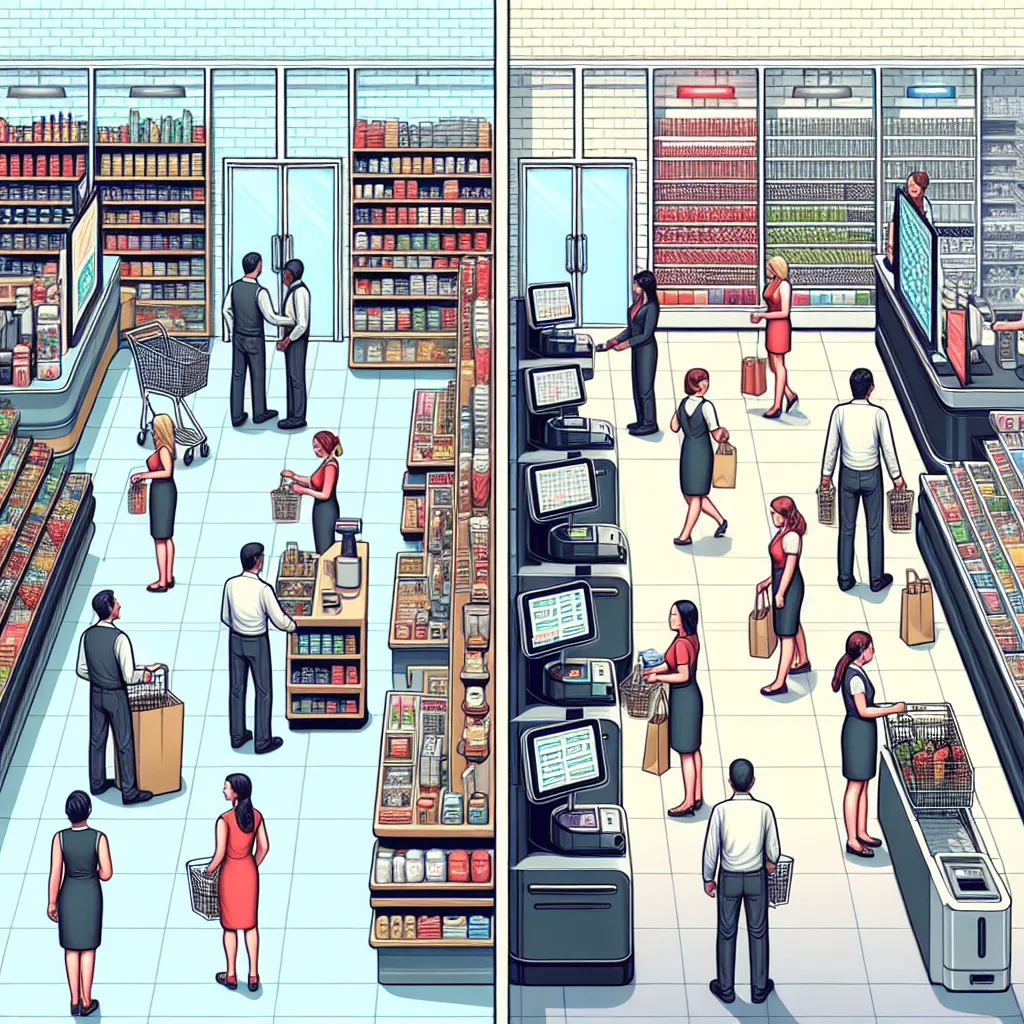The IELTS Reading section is a crucial component of the test, assessing your ability to comprehend complex texts and extract relevant information. Today, we’ll focus on a topic that has been increasingly prevalent in recent years: “Automation’s impact on retail jobs.” This subject has appeared in various forms in past IELTS exams and remains highly relevant, given the rapid technological advancements in the retail sector. As such, there’s a strong possibility that you may encounter a similar theme in future tests.
 Retail automation impact
Retail automation impact
Reading Passage
The Changing Face of Retail: Automation’s Growing Influence
The retail industry has long been a significant employer, providing jobs for millions of people worldwide. However, the landscape of retail employment is undergoing a dramatic transformation due to the increasing adoption of automation technologies. From self-checkout kiosks to inventory management robots, these innovations are reshaping the way retailers operate and, consequently, the nature of retail jobs.
One of the most visible forms of automation in retail is the self-checkout system. Introduced in the late 1990s, these machines have become ubiquitous in supermarkets and department stores. They allow customers to scan, bag, and pay for their items without the need for a human cashier. While this technology has improved efficiency and reduced wait times, it has also led to a decrease in the number of cashier positions available.
Another area where automation is making significant inroads is inventory management. Robots and artificial intelligence systems are being deployed to track stock levels, predict demand, and even reorder products automatically. These technologies can perform these tasks more accurately and efficiently than human workers, leading to reduced labor costs and improved inventory accuracy. However, this also means fewer jobs for inventory clerks and stock managers.
E-commerce has further accelerated the automation trend in retail. Online retailers use sophisticated algorithms to personalize shopping experiences, recommend products, and process orders. Warehouse operations have also been revolutionized by automation, with companies like Amazon using robots to pick and pack orders. While this has created new jobs in areas such as software development and robotics maintenance, it has also reduced the need for traditional warehouse workers.
The impact of automation on retail jobs is not uniform across all sectors. Luxury retailers and specialty stores that prioritize personalized customer service are less likely to fully automate their operations. These businesses often rely on the expertise and interpersonal skills of their staff to provide a high-end shopping experience that cannot be easily replicated by machines.
Despite the challenges posed by automation, the retail industry is not disappearing; it’s evolving. New roles are emerging that require a combination of technological proficiency and traditional retail skills. For instance, the rise of omnichannel retailing has created demand for employees who can manage both online and offline customer experiences seamlessly.
Moreover, automation is creating opportunities for retailers to upskill their workforce. Many companies are investing in training programs to help employees transition into new roles that involve working alongside automated systems. This shift often requires workers to develop skills in areas such as data analysis, customer experience management, and technology troubleshooting.
The future of retail jobs in an automated world remains a topic of debate among economists and industry experts. While some predict significant job losses, others argue that automation will lead to job transformation rather than wholesale elimination. What is clear is that the retail workforce of the future will need to be adaptable, tech-savvy, and focused on tasks that machines cannot easily replicate, such as complex problem-solving and emotional intelligence.
As retailers continue to invest in automation technologies, policymakers and educational institutions face the challenge of preparing the workforce for this new reality. This may involve updating curricula to include more technology-focused skills, promoting lifelong learning, and developing retraining programs for displaced workers.
In conclusion, the impact of automation on retail jobs is profound and multifaceted. While it poses challenges for traditional retail roles, it also opens up new opportunities for those willing to adapt and acquire new skills. The key for both retailers and employees will be to embrace change and focus on developing the unique human qualities that complement, rather than compete with, automated systems.
Questions
True/False/Not Given
Determine if the following statements are True, False, or Not Given based on the information in the passage.
- Self-checkout systems were first introduced in the early 2000s.
- Automation in inventory management has improved accuracy but reduced job opportunities for stock managers.
- Luxury retailers are equally likely to automate their operations as other retail sectors.
- The rise of e-commerce has created new job opportunities in areas such as software development.
- All retailers are investing in training programs to help employees transition into new roles.
Multiple Choice
Choose the correct letter, A, B, C, or D.
-
According to the passage, which of the following is NOT a benefit of automation in retail?
A) Improved efficiency
B) Reduced wait times
C) Increased job opportunities for cashiers
D) Better inventory accuracy -
The passage suggests that the future retail workforce will need to be:
A) Focused solely on customer service
B) Skilled in operating automated systems
C) Adaptable and proficient in technology
D) Specialized in traditional retail tasks
Matching Headings
Match the following headings to the correct paragraphs in the passage. Write the correct number (i-viii) next to questions 8-12.
i. The uneven impact of automation across retail sectors
ii. The role of e-commerce in driving automation
iii. The emergence of new retail roles
iv. The introduction of self-checkout systems
v. The future of retail employment
vi. The challenge for policymakers and educators
vii. The transformation of inventory management
viii. The importance of upskilling the workforce
- Paragraph 2: __
- Paragraph 3: __
- Paragraph 4: __
- Paragraph 5: __
- Paragraph 8: __
Summary Completion
Complete the summary below using words from the box. Write ONE WORD ONLY for each answer.
automation, efficiency, cashiers, inventory, warehouse, personalized, omnichannel, upskill, adaptable, problem-solving
The retail industry is experiencing significant changes due to (13)__. While this has improved (14)__ in many areas, it has also led to a decrease in traditional roles such as (15)__ and (16)__ clerks. However, new opportunities are emerging, particularly in (17)__ retailing, which requires employees to manage both online and offline experiences. Many retailers are investing in programs to (18)__ their workforce, preparing them for roles that require technological proficiency. The future retail workforce will need to be (19)__ and focused on tasks that require complex (20)__ and emotional intelligence.
Answer Key
- False
- True
- False
- True
- Not Given
- C
- C
- iv
- vii
- ii
- i
- v
- automation
- efficiency
- cashiers
- inventory
- omnichannel
- upskill
- adaptable
- problem-solving
Explanations
- False – The passage states that self-checkout systems were introduced in the late 1990s, not the early 2000s.
- True – The passage mentions that automation in inventory management has improved accuracy but reduced jobs for inventory clerks and stock managers.
- False – The passage states that luxury retailers are less likely to fully automate their operations.
- True – The passage explicitly mentions that e-commerce has created new jobs in areas such as software development.
- Not Given – The passage mentions that many companies are investing in training programs, but it doesn’t state that all retailers are doing this.
- C – The passage does not mention increased job opportunities for cashiers as a benefit of automation. In fact, it states that automation has led to a decrease in cashier positions.
- C – The passage concludes that the future retail workforce will need to be adaptable, tech-savvy, and focused on tasks that machines cannot easily replicate.
- iv – This paragraph introduces the concept of self-checkout systems.
- vii – This paragraph discusses how automation is changing inventory management.
- ii – This paragraph focuses on how e-commerce has accelerated the automation trend in retail.
- i – This paragraph discusses how the impact of automation varies across different retail sectors.
- v – This paragraph discusses predictions and debates about the future of retail jobs in an automated world.
13-20: The summary completion answers are based on key information presented throughout the passage, focusing on the main impacts of automation on retail jobs and the skills required for future retail workers.
Common Mistakes
When answering questions about automation’s impact on retail jobs, students often make the following mistakes:
-
Overgeneralizing: Assuming that automation affects all retail sectors equally, when the passage clearly states that luxury and specialty retailers are less likely to fully automate.
-
Misinterpreting job creation: While automation creates some new jobs, it’s important to recognize that it also eliminates many traditional roles. Be careful not to overstate the job creation aspect.
-
Confusing timelines: Pay attention to specific dates mentioned, such as the introduction of self-checkout systems in the late 1990s.
-
Overlooking nuances: The passage presents a balanced view of automation’s impact. Avoid focusing solely on either the positive or negative aspects.
-
Misunderstanding “Not Given”: Remember that if information is not explicitly stated in the passage, even if it seems logical, the answer is “Not Given.”
Vocabulary
- Ubiquitous (adjective) – /juːˈbɪkwɪtəs/ – present, appearing, or found everywhere
- Inroads (noun) – /ˈɪnrəʊdz/ – a gradual, encroaching entrance into a new area or market
- Accelerated (verb) – /əkˈseləreɪtɪd/ – increased in rate, amount, or extent
- Omnichannel (adjective) – /ˌɒmnɪˈtʃænl/ – denoting or relating to a type of retail that integrates different methods of shopping available to consumers
- Upskill (verb) – /ʌpˈskɪl/ – teach (an employee) additional skills
- Adaptable (adjective) – /əˈdæptəbl/ – able to adjust to new conditions
Grammar Focus
Pay attention to the use of present perfect tense in the passage, such as:
“Automation technologies have reshaped the way retailers operate.”
This tense is used to describe actions that started in the past and continue to have an impact in the present. It’s formed with “have/has” + past participle.
Practice using this tense when discussing ongoing trends or changes in various industries.
Tips for IELTS Reading Success
-
Time management: Allocate your time wisely across all sections of the reading test.
-
Skim and scan: Quickly skim the passage for general understanding, then scan for specific information when answering questions.
-
Pay attention to keywords: Identify key terms in both the passage and questions to help locate relevant information.
-
Practice active reading: Engage with the text by underlining key points and making brief notes.
-
Improve your vocabulary: Regularly learn new words and phrases related to common IELTS topics like technology, employment, and societal changes.
-
Read diverse materials: Expose yourself to various types of texts to improve your reading speed and comprehension.
-
Answer all questions: Even if you’re unsure, always provide an answer as there’s no penalty for incorrect responses.
-
Check your answers: If time allows, review your answers for any obvious mistakes or oversights.
By following these tips and regularly practicing with passages like the one on automation’s impact on retail jobs, you’ll be well-prepared for the IELTS Reading test. Remember, success in IELTS Reading comes from a combination of strong vocabulary, effective time management, and well-developed comprehension skills.


